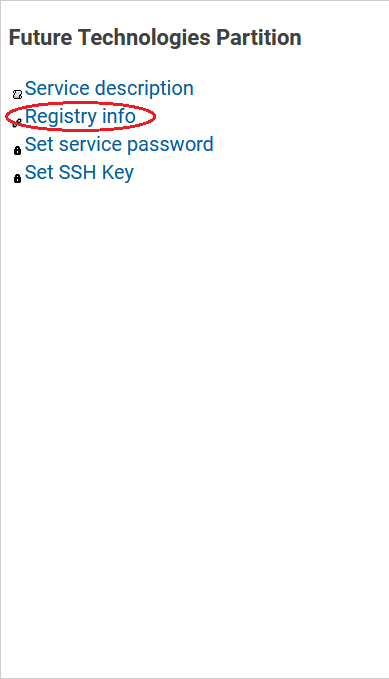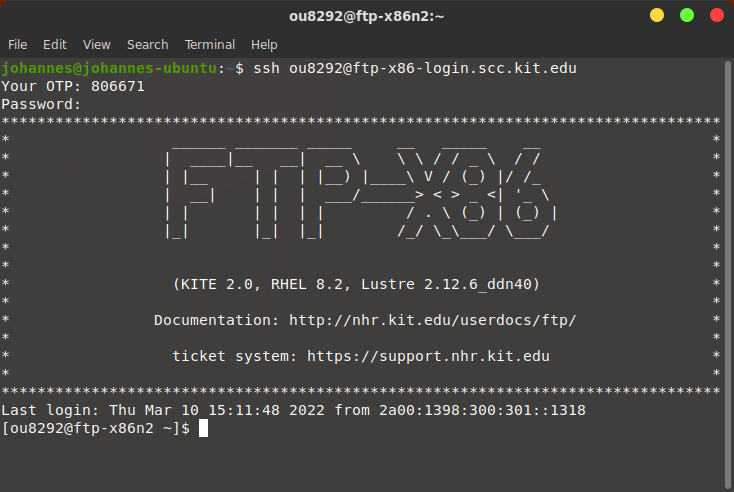Logging In¶
Username lookup¶
Before you can log into a session on the FTP, you have to look up your login username. You can do so on FeLS by clicking on the Registry info link in the Future Technologies Partition service box:

The username can be found on the line Username for login:. In this example image, the username would be hgf_izc0875:

Recommended Tools¶
-
OpenSSH: Supports interactive logins and remote file transfers on a wide variety of operating systems, including Linux, Windows and macOS.
-
MobaXterm: supports interactive logins and remote file transfers on Windows.
-
FileZilla: supports remote file transfer on Windows/Linux/macOS.
SSH login process¶
After finishing the registration process, you can connect to the FTP servers through SSH.
Network access limitations
Please note that you have to be connected to an allowed network to access the FTP. See the network access limitations section for more details.
The Future Technologies Partition is currently split into two different cluster installations with different hardware components, different cluster management software stacks and different login nodes.
You are always granted access to the FTP as a whole, but you have to use different login nodes and there will be minor and major differences between both systems and even individual nodes, depending on which hardware they use. For more details please see the Hardware Overview, Software and Modules, Batch System and Software Development & Performance sections.
Both clusters use the same configuration for 2-Factor Authentication and SSH Key management, and they also use the same service password.
A connection to these login nodes can be established using the following ssh command lines (replace username with your actual username in both cases):
-
FTP-A64 ARM cluster
The login node for this cluster is ftp-a64-login.scc.kit.edu$ ssh username@ftp-a64-login.scc.kit.edu -
FTP-X86 cluster The login node for this cluster is ftp-x86-login.scc.kit.edu
$ ssh username@ftp-x86-login.scc.kit.edu
Host authenticity
When you log in, you may receive the message The authenticity of host '<host address>' can't be established. along with the host key fingerprint. This is intended so you can verify the authenticity of the host you are connecting to. Before you continue you should verify, if this fingerprint matches one of the following:
- RSA:
SHA256:p6Ion2YKZr5cnzf6L6DS1xGnIwnC1BhLbOEmDdp7FA0 - ECDSA:
SHA256:k8l1JnfLf1y1Qi55IQmo11+/NZx06Rbze7akT5R7tE8 - ED25519:
SHA256:yEe5nJ5hZZ1YbgieWr+phqRZKYbrV7zRe8OR3X03cn0
GUI-based access and Jupyter are unavailable on the FTP.
The login nodes are the access point to the compute system and to your $HOME directory on the respective cluster.
Example login process¶
After the connection has been initiated, a successful login process will go through the following three steps:
-
The system asks for a One-Time Password. Generate one using the Software or Hardware Token registered on FeLS (see 2-Factor Authentication) and enter it after the
Your OTP:prompt. -
The systems asks for your service password. This is the password set up for the FTP service in FeLS, not your account password. Enter it after the
Password:prompt. -
You are greeted by the FTP banner followed by a shell prompt.
The result should look like this:

If the Your OTP: prompt doesn't appear, but you immediately get the Password: prompt instead, this means that the system could not find your username. Please make sure that you are using the login username you have looked up as described in the first chapter. If you are sure the username is correct, please contact the support channels.
If the FTP banner appears, but you are presented with an error message and the connection is terminated immediately, please contact the support channels.
Network access limitations¶
Access to the FTP servers is limited to IP addresses from a number of well-known German institutions and networks listed below.
You should be able to connect to the FTP without restrictions if your device is located on one of these networks, e.g. if you are at your office on the campus of one of these institutions or connected to the campus WiFi. If you are outside the mentioned networks (e.g. in your home office), a VPN connection to your home institution has to be established first.
In general it is a good idea to just try if you can access the FTP servers from your office or using your home institution's VPN connection. If it doesn't work immediately, try to force your client to use IPv4 (e.g. ssh -4) or IPv6 (e.g. ssh -6) manually.
If both protocols don't work, or if you are located outside of Germany and haven't been provided with a VPN connection to a German institution, please navigate to https://wieistmeineip.scc.kit.edu/ and provide the support channels with the IP addresses shown on the page. We will then find the best way to get you on the FTP.
List of currently allowed networks¶
- KIT internal networks
- All universities and universities of Applied Sciences in Baden-Wurttemberg
- All Helmholtz member institutions
- All NHR centres
- Many academic and scientific institutions in Germany (Note: some only via IPv6)
SSH Keys¶
In contrast to many other Linux-based systems, it is not possible to self-manage your SSH Keys by adding them to the ~/.ssh/authorized_keys file. Existing files will with this name are not evaluated.
SSH Keys have to be managed via FeLS instead. Please refer to the Using SSH Keys chapter for more information.